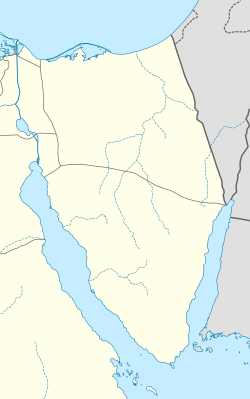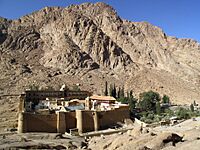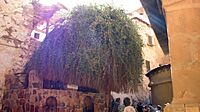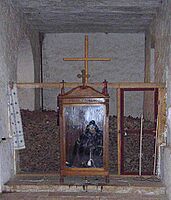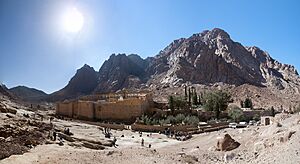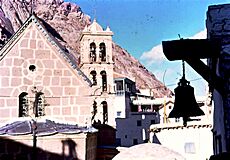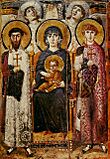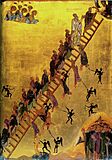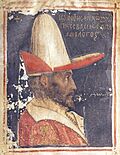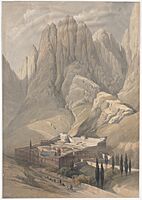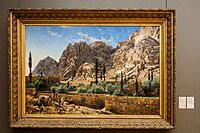Saint Catherine's Monastery facts for kids
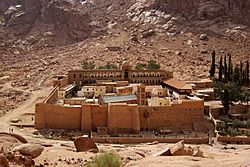
General view of Saint Catherine's Monastery, looking down from Mount Sinai
|
|
| Monastery information | |
|---|---|
| Full name | Sacred Autonomous Royal Monastery of Saint Catherine of the Holy and God-Trodden Mount Sinai Greek: Ιερά Αυτόνομος Βασιλική Μονή Αγίας Αικατερίνης του Αγίου και Θεοβαδίστου Όρους Σινά |
| Other names | Monastery of Saint Katherine Moni tis Ayas Ekaterinis |
| Order | Church of Sinai |
| Denomination | Greek Orthodox Church |
| Established | AD 565 |
| People | |
| Founder(s) | Justinian I |
| Site | |
| Location | Saint Catherine, South Sinai Governorate, Egypt |
| Country | Egypt |
| Coordinates | 28°33′20″N 33°58′34″E / 28.55556°N 33.97611°E |
| Visible remains | Catherine of Alexandria |
| Official name: Saint Catherine Area | |
| Type: | Cultural |
| Criteria: | i, iii, iv, vi |
| Designated: | 2002 (26th session) |
| Reference #: | 954 |
| Region: | Arab States |
Saint Catherine's Monastery is a very old Christian monastery located in the Sinai Peninsula in Egypt. It sits at the base of Mount Sinai. This monastery was built between 548 and 565 AD. It is known as the world's oldest Christian monastery that has been lived in continuously since it was built.
The monastery was ordered by the Byzantine emperor Justinian I. It was built around a spot believed to be where Moses saw the burning bush. Later, the body of Catherine of Alexandria was supposedly found nearby and brought to the monastery. Her relics made the monastery a very important place for Christian pilgrimage, and it was eventually named after her.
The monastery is managed by the Church of Sinai, which is part of the larger Greek Orthodox Church. In 2002, it became a World Heritage Site. This is because it is very important to the three main Abrahamic religions: Judaism, Christianity, and Islam.
The monastery's library has many rare and special books. These include the Codex Sinaiticus and the Syriac Sinaiticus. It also has a collection of early Christian icons. One of these is the earliest known picture of Christ Pantocrator.
Saint Catherine's Monastery is surrounded by three mountains. These are Willow Peak, Jebel Arrenziyeb, and Mount Sinai. Mount Sinai is traditionally believed to be the biblical mountain where Moses received the Ten Commandments.
Contents
Christian Traditions and Sacred Sites
The monastery was built around a place that many believe is where the burning bush appeared to the prophet Moses. Inside the monastery, there is also the "Well of Moses." It is said that Moses met his future wife, Zipporah, at this well. This well still provides water for the monastery today. The entire site is considered holy by Judaism, Christianity, and Islam.
Many years after the monastery was founded, the body of Saint Catherine was reportedly found in a cave nearby. Her holy remains are still kept inside the monastery. This has made it a very popular place for Christians to visit on a pilgrimage. The monastery celebrates its main feast day on the Feast of the Transfiguration.
-
The monastery's centuries-old bramble is considered to be the biblical burning bush.
-
"Well of Moses", where Moses is said to have met his future wife, Zipporah
-
Skeleton of the monk Stephanos, in his robe, in front of the ossuary
A Look at History
The first records of monks living at Mount Sinai come from a travel diary. It was written in Latin by a Christian pilgrim named Egeria around 381–386 AD.
The monastery was built by order of the Byzantine emperor Justinian I. He ruled from 527 to 565 AD. It was built around the Chapel of the Burning Bush. This chapel was ordered by Helena, mother of Constantine I, at the spot where Moses supposedly saw the burning bush. The bush growing on the monastery grounds is believed to be that very bush. The monastery's roof structure is the oldest known surviving roof truss in the world.
During the time of the First Crusade, European Christians became more interested in the Sinai region. This led to more pilgrims visiting the monastery. The monastery was supported by its other properties in places like Egypt, Palestine, and Syria. For many centuries, the monastery had monks from different backgrounds, including Arab, Greek, and Syrian.
A mosque was added to the monastery during the Fatimid Caliphate (909–1171). It was regularly used until the 13th century and is still used for special events today. The monastery is surrounded by strong walls that have helped protect it over time. Until the 20th century, people entered through a door high up in the outer walls.
The monastery, along with other religious sites nearby, forms the entire Church of Sinai. This church is led by an archbishop, who is also the head of the monastery. The archbishop usually lives in Cairo.
A traveler named Felix Fabri visited the monastery in the 15th century. He wrote about its gardens, which had many fruit trees, herbs, and grains. He noted there were over three thousand olive trees, many fig and pomegranate trees, and almonds. The olives were used to make oil for lamps and for cooking.
The monastery faced challenges over time. In 1505, it was attacked and robbed. Even though the rulers at the time tried to help, they couldn't fully protect the monks from local groups. In 2017, there was an incident near the monastery that affected local police.
Manuscripts and Ancient Books
The monastery's library was started between 527 and 565 AD. It is recognized by Guinness World Records as the world's oldest library that has been open continuously. It holds the second-largest collection of old books and manuscripts in the world. Only the Vatican Library has more.
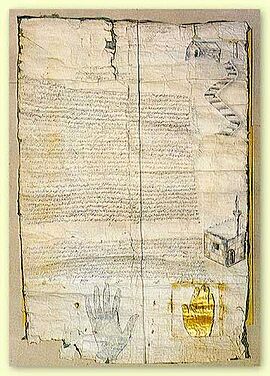
The library contains books in many languages, including Greek, Syriac, Arabic, and Latin. It also has very rare Hebrew and Coptic books.
In 1859, a researcher named Constantin von Tischendorf found the Codex Sinaiticus at the monastery. This 4th-century book was the oldest almost complete copy of the Bible known at the time. The monastery later received a gift of 9000 rubles for the manuscript. The Codex is now in the British Library in London. In 2009, a new piece of the Codex Sinaiticus was found in the monastery's library.
Important Discoveries by Agnes Smith Lewis and Margaret Dunlop Gibson
In 1892, Agnes S. Lewis found an early palimpsest manuscript of the Gospel in the monastery's library. This became known as the Syriac Sinaiticus. A palimpsest is a manuscript where the original writing was erased, and new text was written over it. The original text was later read by scholars.
The monastery also has a copy of the Ashtiname of Muhammad. This document is said to be from Muhammad and promises protection to the monastery.
Many of the most important manuscripts have been filmed or digitized. This makes them available for scholars to study. The library was also renovated and reopened in late 2017.
Sinai Palimpsests Project
Since 2011, a team of scientists and scholars has been working on the Sinai Palimpsests Project. They photograph, digitize, and study the monastery's collection of palimpsests.
Because parchment was expensive, monks would erase old texts and write new ones over them. Scientists use special imaging techniques to see the old, erased texts. These images are now available online for researchers.
By June 2018, over 160 palimpsests had been found. More than 6,800 pages of old texts have been recovered. These include old Greek poems, an early recipe from the Greek doctor Hippocrates, and parts of ancient Christian texts. They also provide information about languages that are no longer spoken, like Caucasian Albanian.
Protecting the Manuscripts
The Saint Catherine Foundation worked with a research center to create special steel boxes for the monastery's rare manuscripts. The goal is to store 2,187 parchment manuscripts in individual stainless steel boxes. These boxes offer the best protection against the desert environment, earthquakes, and damage from age.
Stainless steel was chosen over wood because wood can release acidic gases that might harm the colors in the old pictures. Steel boxes also protect against insects and are not flammable. Each box has a system to reduce oxygen, which helps protect against fire damage.
Each box is made from a special type of stainless steel. The inside is lined with a soft foam to protect the manuscripts. Each manuscript is wrapped in acid-free paper and placed carefully inside its box.
Amazing Artworks
The monastery is home to many priceless works of art. These include mosaics and the world's best collection of early icons. Many of these icons were made using encaustic, a method using hot wax. The monastery also has many old church objects, cups, and containers for holy items.
The large collection of icons includes some from the 5th and 6th centuries. These are very rare because the monastery was never attacked or damaged during times when many icons were destroyed. The oldest icon showing a scene from the Old Testament is also kept here. The monastery was also important for developing a mixed style of art called Crusader art. It has over 120 icons made in this style, which is the largest collection anywhere.
Icons Gallery
-
Saint Peter depicted in 6th-century hot wax icon
-
The Last Judgement, 11th-12th century, by John Tokhabi
-
13th century Byzantine icon of Saint Michael the Archangel
-
Emperor John VIII Palaiologos
-
Icon of Saint Catherine of Alexandria
-
12th century icon of Saint George and David IV of Georgia
Historical Images
-
Carsten Niebuhr (1762)
-
Description de l'Égypte (1809)
-
David Roberts (1839), published in The Holy Land, Syria, Idumea, Arabia, Egypt, and Nubia
Panoramic View
In Literature
The French writer Pierre Loti describes the monastery and its treasures in his 1895 book, Le désert. This book tells about his journey by camel through the Sinai desert.
See also
 In Spanish: Monasterio de Santa Catalina del Monte Sinaí para niños
In Spanish: Monasterio de Santa Catalina del Monte Sinaí para niños
- Archbishop of Mount Sinai and Raithu
- Ashtiname of Muhammad
- Codex Sinaiticus
- Ladder of Divine Ascent
- Oldest churches in the world
- Syriac Sinaiticus


